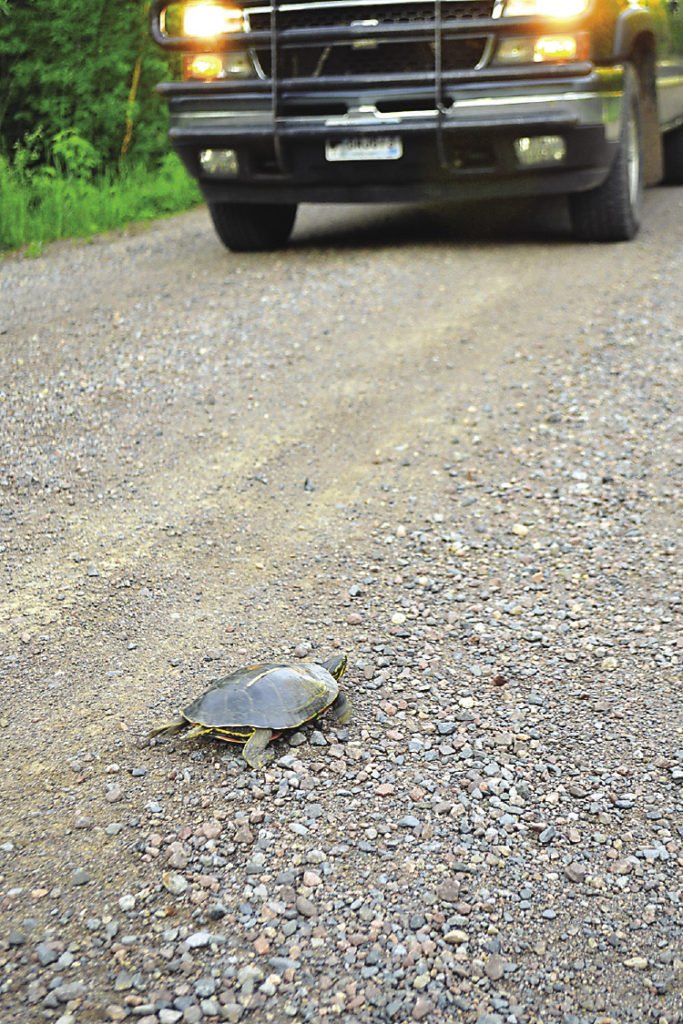June means a lot of things in the Northern Wilds:
shorts weather, family vacations, fishing…
and turtles crossing the road.
Late May and June is when drivers frequently encounter turtles in the road, so be alert. That’s when turtles leave their homes in lakes, ponds, streams and wetlands to lay their eggs. Sometimes they lay their eggs right in the shoulder of the road. At other times, you may see them crossing the road to reach more desirable habitat. They may travel a half-mile or more from water to find a suitable nesting site.
Turtles look for open areas that receive a lot of sunlight when choosing a site to lay their eggs. They like areas with loose, sandy soil, which is easy to dig. The female scrapes out a hole with her claws, then lays her eggs. She buries the eggs with the loose dirt and returns to her aquatic home. The sun’s heat incubates the eggs. It takes a couple months before the eggs hatch.
So as you’re driving come June, keep your eyes peeled for turtles. Alert drivers can avoid turtles crossing the road much easier than turtles can avoid drivers, because turtles are famously slow. Some of the highest rates of turtle road mortality occur on roads that run through wetlands, especially when the wetlands are within 100 meters of the road.
Tips to Perform a Turtle Rescue
If you see a turtle crossing the road, follow these tips from the Minnesota DNR:
- Leave them alone if they are not in danger. Turtles crossing roads in late May and June are often moving to familiar nesting locations. They know where they are going.
- Don’t put yourself or others in danger. Simply pulling off the road and turning on your hazard lights may alert other drivers to slow down.
- If you decide to help the turtle cross the road, turn on your signal, slowly pull off the road, turn on your hazard lights and watch for approaching traffic.
- Pick up the turtle by the back of its shell, not by the tail. (Picking up a turtle by the tail can damage its spinal cord.)
- Use caution when handling turtles. All turtles can bite, but snapping turtles bite hardest.
- Snapping turtles can be moved with a snow shovel. Other options include picking them up by their hind legs or having them bite down on a stick and carefully dragging them to safety.
- Move the turtle in the direction it is heading. Do not relocate the turtle to a new area, even if the habitat seems unsuitable.
- Wash your hands after handling a turtle.
Local Turtle Species:
The most common species in the Northland are painted turtles and snapping turtles. If you’re lucky, you may spot a Blanding’s turtle or a wood turtle. (These latter two species are threatened species in Minnesota, so if you see one, report the date and location of the sighting to the DNR at mbs.report@state.mn.us.)
- Painted turtles are the most common turtle in our region and are probably the most familiar. The carapace (top of the shell) is black or olive green, while the plastron (bottom of the shell) is bright orange. A painted turtle’s head and legs are black with yellow stripes. Females are larger than males, growing up to 10 inches in length. Painted turtles usually lay 2-10 eggs. The young hatch in a couple months, but generally stay in the nest until the following spring.
- Snapping turtles look imposing! They are large, with an average carapace size of 8-14 inches in length. Snappers usually weigh 10 to 35 pounds, but the largest ever recorded in Minnesota weighed a whopping 65 pounds! Snapping turtles usually have green or brown carapaces. Often, they are covered with moss. The back of the carapace has a serrated look. Snappers have long tails that look spiky. They have thick heads with powerful jaws. When threatened, snappers may hiss and snap their jaws. Females usually lay 25 to 50 eggs, but may lay up to 100.
- Blanding’s turtles are a state-threatened species in Minnesota. This species spends more time on land than many other turtle species. Blanding’s turtles are recognized by their high-domed carapace and the bright-yellow coloration on their throats and chins. They have black carapaces in a scale-like pattern, flecked with yellow dots. These turtles average 6-10 inches in carapace size. They may travel up to a mile from water to lay their eggs. Partially because of this, mortality of young turtles is high. Females don’t reach maturity until they are 12 years old. They lay 10 to 26 eggs. This long-lived species has been known to reach age 70 in Minnesota.
- The wood turtle depends on forested habitat along rivers. This long-lived species doesn’t mature until it reaches 14 to 18 years old. Wood turtles have olive-green carapaces that are made up of individual scutes, giving the appearance of large scales, but more pointed than the flat scales of Blanding’s turtles. The carapace generally measures 5.5 to 8 inches in length. The head is dark, but the legs and underside of the neck are yellow. In late May or June, female wood turtles lay 4-18 eggs. The hatchlings emerge in August or September. Wood turtles are state-threatened in Minnesota.

